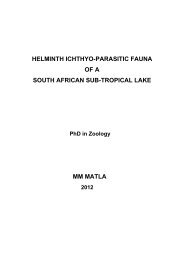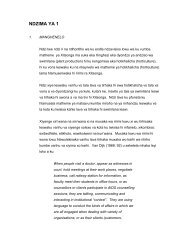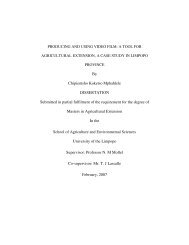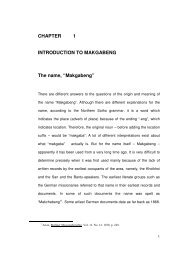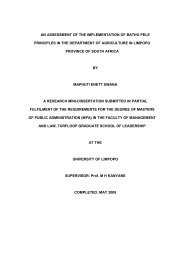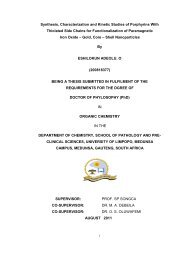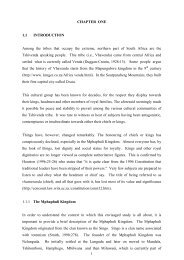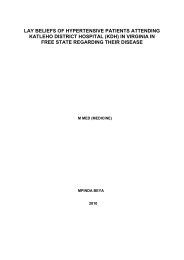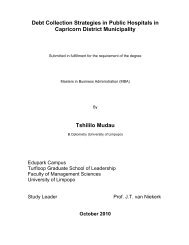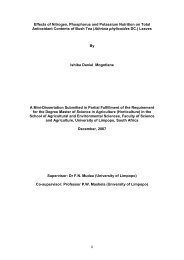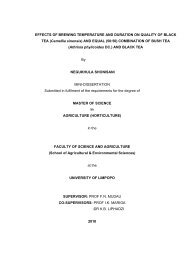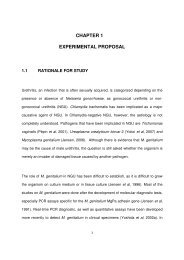Mmushi T MSc (Microbiology).pdf
Mmushi T MSc (Microbiology).pdf
Mmushi T MSc (Microbiology).pdf
You also want an ePaper? Increase the reach of your titles
YUMPU automatically turns print PDFs into web optimized ePapers that Google loves.
phytochemical analysis (section 2.4.1.). The plates were developed in EMW, CEF, and<br />
BEA solvent systems. Bio-autograms were left to fan-dry for 3-5 days to completely<br />
evaporate the mobile phases and each bioautogram was sprayed with each of the<br />
bacterial strains and then incubated at 37°C for 24 hrs in humid conditions. After<br />
incubation the bioautograms were sprayed with a visualization stain (INT), and<br />
incubated further at 37°C for 2-4 hrs in sealed plastic boxes to allow the pink colour to<br />
develop. The appearances of clear zones/white spots on the bioautograms were<br />
considered as areas of growth inhibition whereas a pink-red colour indicated growth.<br />
2.5. Isolation of bioactive compounds<br />
2.5.1. Preparation of crude extracts<br />
Exhaustive extraction method was used to extract ground leaves powder (2 kg) of<br />
Apodytes dimidiata subsp dimidiata with acetone. Plant material was extracted for three<br />
to four hours with 6 litres of acetone. The extracts were then filtered and concentrated<br />
using a Bϋchi rotary evaporator (Labotec) under reduced pressure, rotating at 100 rpm<br />
and the water bath temperature of 40°C. The concentrated extracts were transferred<br />
into pre-weighed beakers, dried under fan and weighed.<br />
2.5.2. Column chromatography<br />
The solvent-solvent fractionation was selected to simplify extracts by fractionating the<br />
chemical compounds into broad groups based on their solubilities. A Bucher funnel (13<br />
cm x 5.7 cm, 150 g) was packed with 1.13 kg silica gel 0.04-0.063 mm (MERCK). Eighty<br />
five grams of finely ground acetone extract was thinly spread on top of the overnight<br />
packed silica gel and then covered with cotton wool and eluted with 100% DCM to<br />
100% methanol (MEOH). The column was eluted with 4 L of 100% DCM, 2 L of 90:10<br />
DCM: MEOH, 2 L of 70:30 DCM: MEOH, 2 L of 50:50 DCM: MEOH, 2 L of 30:70 DCM:<br />
MEOH and 1 L of 100% MEOH and sub fractions (250 ml) of each fraction were<br />
collected in Erlenmeyer flasks.<br />
41



